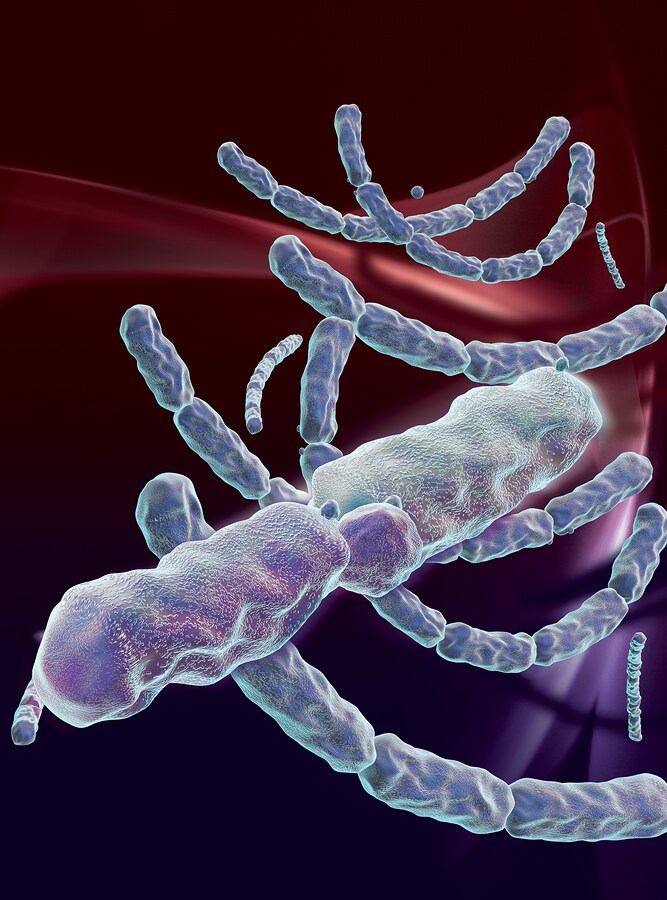 The spores of Bacillus anthracis are classified as a Category A pathogenic agent. The Centers for Disease Control (CDC) considers them highly likely to be used as agents in bioterrorism attacks — and has indeed dealt with this bioweapon in North America in the last 15 years. In order to contain such threats, prompt identification of agents such as anthrax is necessary. Unfortunately, since B. anthracis belongs to the six-member B. cereus group and shows 99% sequence similarity with two other non-pathogenic group members found widely in the environment, prompt and accurate identification is difficult.
The spores of Bacillus anthracis are classified as a Category A pathogenic agent. The Centers for Disease Control (CDC) considers them highly likely to be used as agents in bioterrorism attacks — and has indeed dealt with this bioweapon in North America in the last 15 years. In order to contain such threats, prompt identification of agents such as anthrax is necessary. Unfortunately, since B. anthracis belongs to the six-member B. cereus group and shows 99% sequence similarity with two other non-pathogenic group members found widely in the environment, prompt and accurate identification is difficult.
Chenau et al. (2013) present a combined proteomics and genomics approach that solves this identification problem. By comparing the anthrax spores with examples from environmentally relevant and related species from the Bacillus genus, they have isolated 11 proteins unique to B. anthracis that show good potential for rapid identification of the species.1
B. anthracis requires Biosafety level 3 containment in the laboratory. Chenau and co-workers cultured the bacterium, induced spore formation, and then inactivated the material prior to protein extraction (in order to maintain safe working conditions in subsequent experimental procedures). They then chose 55 reference strains from the 268 species in the genus Bacillus to compare with the anthrax spores, inducing sporulation in 48 of them.
Initially, the researchers focused on finding protein markers in 12 species strains from the Bacilllus cereus group: B. anthracis (n=5), B. cereus (n=5) and B. thuringiensis (n=2). Using bottom-up liquid chromatography–tandem mass spectrometry (LC-MS/MS), they examined spore proteoforms using an LTQ-Orbitrap Discovery mass spectrometer (Thermo Scientific), digesting samples using both trypsin and endoproteinase Glu-C to maximize protein identification. The researchers then compared spectral data against the UniProtKB/TrEMBL database for the B. cereus group, isolating 11 proteins unique to anthrax spores.
They repeated this search for unique protein markers using an untargeted, top-down LC-MS/MS proteomics approach on intact proteins. These data agreed with the initial bottom-up results and added a new protein, small acid-soluble spore protein-B (SASP-B), to the list of candidates.
Chenau et al. then further validated the exclusivity of the candidate list of 12 protein markers, using both top-down and bottom-up LC-MS/MS approaches, to analyze a greater number of Bacillus strains (55 in total, 48 spore extracts). From this larger data set they confirmed exclusivity in 11 of the proteins for identifying B. anthracis.
Protein identity was further confirmed by PCR amplification and DNA sequencing for the 11 candidates in the full set of reference strains (n=55). During this step, the researchers excluded two proteins from the final list.
Using strict selection criteria, Chenau and co-authors chose four candidate protein markers – SASP-gamma, 30S ribosomal protein S10, putative lipoprotein, and 60kDa chaperone proteins – in addition to SASP-B, which they had previously identified as unique to anthrax spores,2 for further analysis. They devised a multiplex selected reaction monitoring (SRM) protocol with stable isotope-labeled peptides as internal standards and analyzed the candidates using a triple quadrupole TSQ Quantum Ultra mass spectrometer (Thermo Scientific). Researchers found that signals for four of these proteins were only found in samples from B. anthracis and not from the non-pathogenic Bacillus species. SASP-B was the only protein excluded as a discriminatory marker following this assay.
Additionally, the four markers were detectable by the LC-SRM method even when spores were 100-fold less abundant than the non-pathogenic reference strains. This is considered important because diagnostic material usually comprises a complex matrix of substances.
Chenau et al. conclude that their method is a valid and useful addition to the detection of anthrax spores in environmental samples. They describe their methods as comprehensive, since they used a combination of proteomics and genomics approaches to fully validate the protein markers in a large number of carefully selected, environmentally relevant Bacillus strains. Furthermore, they suggest that their LC-SRM assay shows potential as a high-throughput, sensitive detection protocol for forensic investigation in suspected bioterrorism attacks.
References
1. Chenau, J., et al. (2013) “Identification and validation of specific markers of Bacillus anthracis spores by proteomics and genomics approaches,” Molecular and Cellular Proteomics [e-pub ahead of print],
2. Chenau, J., et al. (2011) “Sensitive detection of Bacillus anthracis spores by immunocapture and liquid chromatography-tandem mass spectrometry,” Analytical Chemistry, 83 (pp. 8675–82).
Post Author: Amanda Maxwell. Mixed media artist; blogger and social media communicator; clinical scientist and writer; SAHM and expat trailing spouse. A digital space explorer, engaging readers by translating complex theories and subjects creatively into everyday language.
Post Author: Amanda Maxwell. Mixed media artist; blogger and social media communicator; clinical scientist and writer; SAHM and expat trailing spouse.
A digital space explorer, engaging readers by translating complex theories and subjects creatively into everyday language.
Leave a Reply